Chennakeshava Temple: Exploring The Magnificence Of Belur’s Architectural Gem
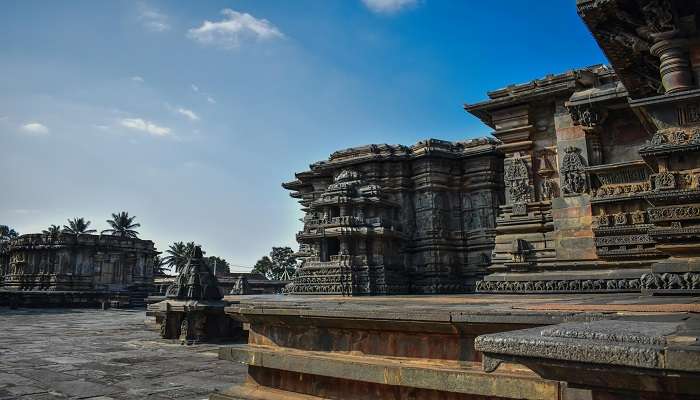
Built in the heart of the picturesque town of Belur, the Chennakeshava temple stands as a breathtaking testament to the architectural brilliance of the Hoysala Empire. This exquisite masterpiece is a captivating combination of detailed carvings, motifs, and sculptures that leave visitors spellbound. Stepping inside, you are enveloped in an atmosphere of reverence and awe. The magnificent central shrine houses a beautifully carved image of Lord Chennakesava, an avatar of Lord Vishnu. Each pillar and each sculpture is a testament to the skill and dedication of the Hoysala artisans, who transformed stone into living works of art. Read this blog till the end to know more about this beautiful temple.
Chennakeshava Temple: An Overview
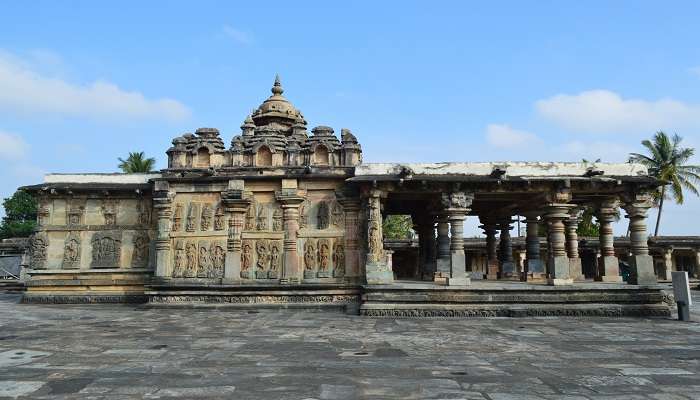
The Chennakesava temple, also known as the Keshava, Kesava, or Vijayanarayana temple, is a remarkable Hindu temple in Hassan district of Karnataka. Commissioned by King Vishnuvardhana of the Hoysala Empire in 1117 CE, this magnificent temple was built on the banks of the Yagachi River, the capital of the Hoysala Empire. The construction of this grand temple spanned an impressive 103 years across three generations of the Hoysala rulers. Dedicated to Vishnu, the temple’s name, Chennakesava translates to “handsome Kesava,” which is one of the names of the Hindu god. Since its inception, the Chennakeshava temple Belur has remained an active place of worship and a significant pilgrimage site for Vaishnavites.
The temple’s artwork vividly depicts scenes from secular life in the 12th century, including dancers, musicians, and pictorial narratives from Hindu epics like the Ramayana, Mahabharata, and Puranas, adorning numerous friezes. While primarily a Vaishnava temple, the Chennakesava temple reverentially incorporates elements from Shaivism and Shaktism and even includes images of a Jina from Jainism and the Buddha from Buddhism. This reflects the diverse religious and cultural perspectives of 12th-century South India under Hoysala’s rule. This inclusivity of beliefs and cultures makes the temple a fascinating destination if you are interested in Indian heritage.
Must Read: Offbeat Places In Coorg
Chennakeshava Temple History
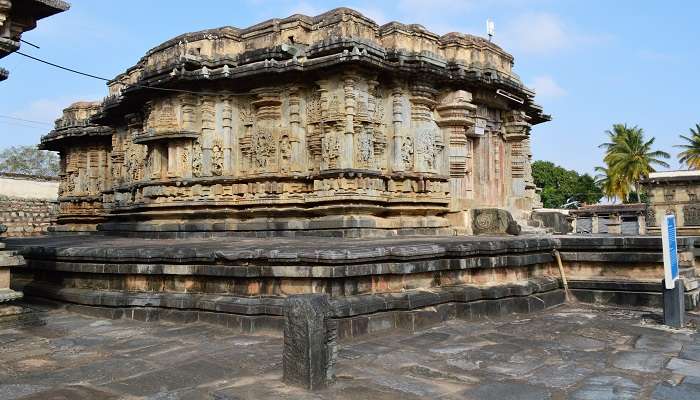
Sri Chennakeshava temple stands as a masterpiece of Hoysala architecture and a testament to the artistic, cultural, and theological perspectives of 12th-century South India. A brief timeline of its development is as follows:
- Commissioned by King Vishnuvardhana
Hoysala King Vishnuvardhana ascended to power in 1110 CE. In 1117 CE, he built the Chennakeshava temple on the banks of the Yagachi River in Belur, an early Hoysala capital.
- Built by Three Generations
The temple, which was built over three generations and took an impressive 103 years to complete, reflects the rising luxury, political power, and deep spiritual dedication to Sri Vaishnavism.
Vishnuvardhana’s descendants completed the Hoysaleswara Temple in 1150 CE and other temples, such as the Chennakesava Temple in Somanathapura, in 1258 CE. These temples are located about 200 kilometres apart. The Hoysalas employed renowned architects and artisans who developed a new architectural tradition, the Karnata Dravida.
Chennakeshava Temple: Structure and Architecture
Sri Chennakeshava temple is a masterpiece of Hoysala architecture. Its structure and design are as follows:
1. Ekakuta Vimana Design

The Chennakeshava temple Belur is designed in the Ekakuta Vimana style, which is characterised by a single shrine. This shrine is square, with each side measuring 10.5 meters. A significant feature of the temple is a large vestibule that connects the shrine to the mandapa, or hall, which is one of the main attractions of the temple. The mandapa is expansive, consisting of 60 bays, and is adorned with intricate carvings and sculptures, showcasing the exquisite craftsmanship of the period.
Suggested Read: Mysore To Kerala Road Trip
2. Star-Shaped Structure
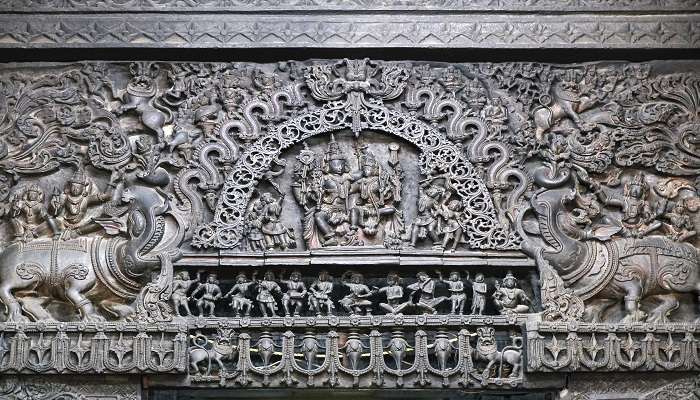
The main temple of the Chennakeshava complex is a star-shaped structure that stands on a raised platform known as Jagati. This temple comprises three main parts. The first is the Garbhagriha, or Inner Sanctum, which houses the deity Chennakeshava. The second component is the Sukanasi, or Vestibule, which connects the sanctum and the mandapa. Lastly, the Navranga Mandapa, a hall beautifully decorated with captivating artwork, adds to the temple’s grandeur.
3. Superstructure (Vimana)
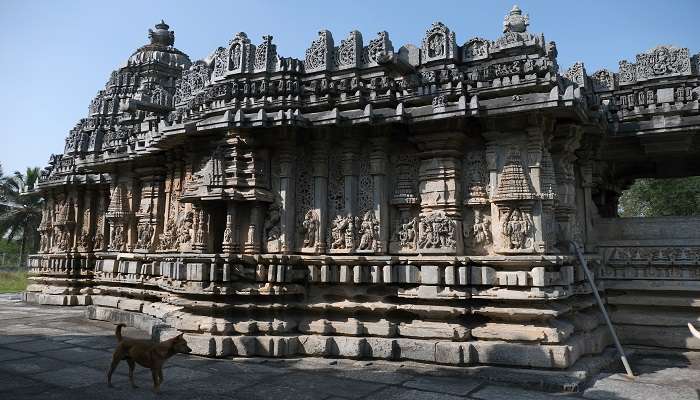
The original superstructure, or tower that was situated on top of the vimana (the main temple structure) of the Chennakeshava Temple is unfortunately no longer present. It is believed that in the past, this superstructure was constructed using brick and mortar. It was likely supported by wooden structures and covered with copper sheets gilded with gold. This historical detail adds to the rich heritage and grandeur of the temple.
Suggested Read: Hoysaleswara Temple
4. Artwork and Iconography
The temple is a marvel of artistry, with its walls, pillars, and ceilings embellished with intricate sculptures, reliefs, and friezes. The artwork breathes life into scenes from secular life in the 12th century, including depictions of dancers and musicians. The temple also serves as a canvas for pictorial narrations from Hindu texts such as the Ramayana, Mahabharata, and Puranas, vividly portrayed in numerous friezes. What makes this temple unique is its incorporation of themes from Shaivism, Shaktism, and Jainism, and it even features images of Buddha. This amalgamation of diverse religious themes is indeed intriguing.
Chennakeshava Temple: Best Time to Visit
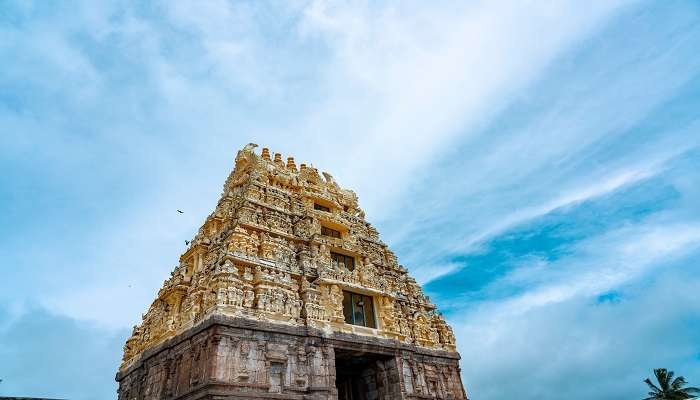
To make the most of your visit, timing is key. So, when is the best time to experience the magnificence of the Chennakeshava temple? The best time to visit is:
When the Weather is Pleasant
November to February offers comfortable daytime temperatures ranging from the low 20s to mid-30s Celsius (70s to low 90s Fahrenheit). Evenings and nights are pleasantly cool, making it enjoyable to spend time outdoors.
During Festivities
You might even be lucky to witness some of Karnataka’s local festivals, such as Kambala (a traditional buffalo race) in January and Makar Sankranti (a harvest festival) celebrated in January. These festivals add to the vibrant atmosphere and provide a glimpse into the local culture.
When it is More Peace
While the temple does attract tourists year-round, the crowds are generally smaller during the winter months compared to the peak summer season (April- May). This allows you to appreciate the temple’s beauty more peacefully.
Suggested Read: Coorg to Ooty Road Trip
How To Reach Chennakeshava Temple?
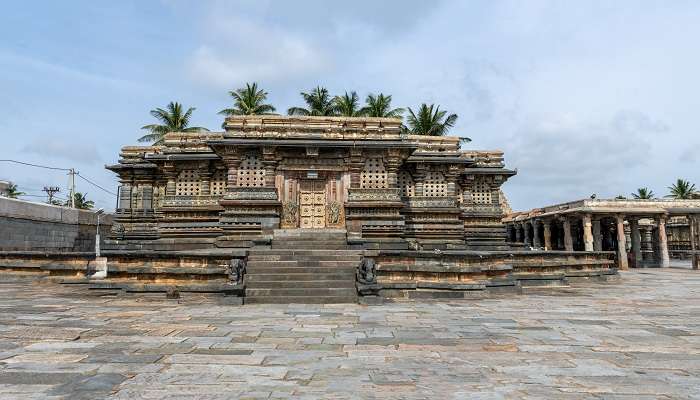
Below is a breakdown of how to reach the Chennakeshava temple using various modes of transportation:
By Air
- The Bengaluru International Airport (BLR) is the closest, approximately 130 Km from Belur.
- You can hire a taxi or cab to reach Belur from the airport. Depending on traffic conditions, the ride takes approximately 2-3 hours.
- Alternatively, you can take a bus from the airport to Kempegowda Bus Station (Majestic) in Bengaluru and then take another bus to Belur.
By Train
- The nearest central railway station is Hassan Junction railway station (HAS), around 28 Km from Belur.
- Several trains connect major Indian cities to Hassan, including Bengaluru, Chennai, Mumbai, and Delhi.
- Once at Hassan station, you can hire a taxi, take an auto rickshaw, or take a bus to Belur.
By Road
- Belur is well-connected by road to major cities in Karnataka and surrounding states. National Highway 75 (NH75) passes through Hassan, making it easily accessible.
- If you are comfortable with road trips, you can drive from your starting point or rent a car in Bengaluru or Mysore to reach Belur.
- Here are the distances from some major cities to Belur:
- Bengaluru: 120 Km
- Mysore: 180 Km
- Mangalore: 250 Km
- Public buses operated by the Karnataka State Road Transport Corporation (KSRTC) connect Belur to various towns and cities within the state.
Chennakeshava Temple Timings
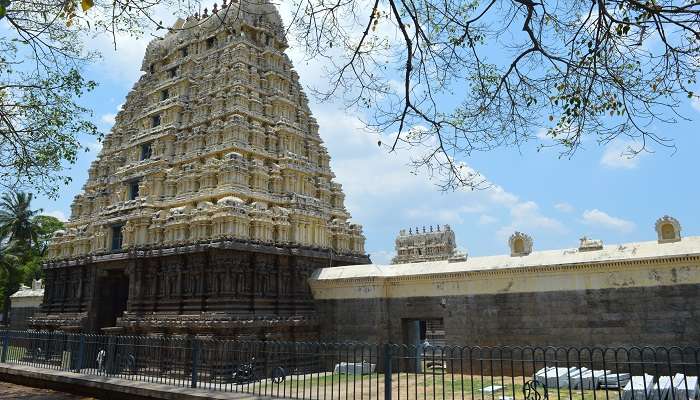
Before planning your visit, it is important to familiarise yourself with the opening and pooja timings of the Chennakeshava Temple. The Chennakeshava Temple timings are as follows:
Opening and Closing Hours
The temple is open every day from 7:30 am to 7:30 pm. The Chennakeshava Temple maintains consistent opening timings, ensuring accessibility for pilgrims on regular days.
Inner Sanctum Timings (Darshan)
You can partake in Darshan at the Chennakeshava Temple without interruption from 7:30 a.m. to 7:30 p.m., offering ample time for spiritual reverence throughout the day.
Pooja Timings
| Pooja | Timing |
| Mangala Aarti | 6:30 am |
| Abhisheka | 7:30 am |
| Alankara Puja | 8:30 am |
| Madhyana Aarti | 12:00 pm (noon) |
| Utsava Puja | 7:00 pm |
| Night Puja | 8:30 pm |
Further Read: Subramanya Swamy Temple
The Chennakeshava Temple is a breathtaking testament to the architectural brilliance of ancient India. The Chennakeshava temple’s history, architecture and serene ambience make it a must-visit destination for anyone exploring Karnataka’s cultural heritage. Ready to immerse yourself in the wonders of Karnataka? Book your trip to Karnataka today and experience the awe-inspiring beauty of the Chennakeshava temple and the many other treasures this enchanting state offers. Start planning your adventure now!
For our editorial codes of conduct and copyright disclaimer, please click here.
Cover Image Source: Shutterstock
Frequently Asked Questions About Chennakeshava Temple
What is special about Chennakeshava Temple?
The Chennakeshava temple, also known as Keshava or Vijayanarayana temple, stands as a testament to the artistic brilliance and cultural richness of 12th-century South India.
Who is Lord Chennakesava?
Lord Chennakesava is a form of Lord Vishnu, the Hindu god of preservation. 'Chennakesava' literally translates to 'handsome Kesava' (Kesava being another name for Vishnu).
Who is the king of Chennakeshava Temple?
The temple owes its existence to the vision and patronage of King Vishnuvardhana, who ruled the Hoysala dynasty during its construction.
Who built the Chennakeshava Temple in Somanathapura?
The Chennakeshava temple in Somanathapura, Karnataka, was built by Somanatha Dandanayaka, a general of the Hoysala King Narasimha III, in 1258 CE. It’s a UNESCO World Heritage site known for its intricate Hoysala architecture and extensive friezes of Hindu scriptures.
Who destroyed Chennakeshava Temple?
The Chennakeshava temple has a history of being frequently damaged and looted during wars, but it has always been restored and repaired. It suffered destruction during Muslim invasions in the Hoysala kingdoms. The initial attack was led by Malik Kafur, a general of Alauddin Khilji, in 1311, and later in 1326, the remaining structures were destroyed by Muhammad Bin Tughlaq.
People Also Read:
Kartik Swami Temple Triyuginarayan Temple Meenakshi Temple

Get ready to wander the world through amazing visual tours that we provide via our blogs and stories. As a content writer, I love sharing incredible travel experiences that inspire readers to plan their own adventures and create unforgettable memories. From planning to execution, everything has already been served in these amusing tales. Let’s explore the world together, one destination at a time!











